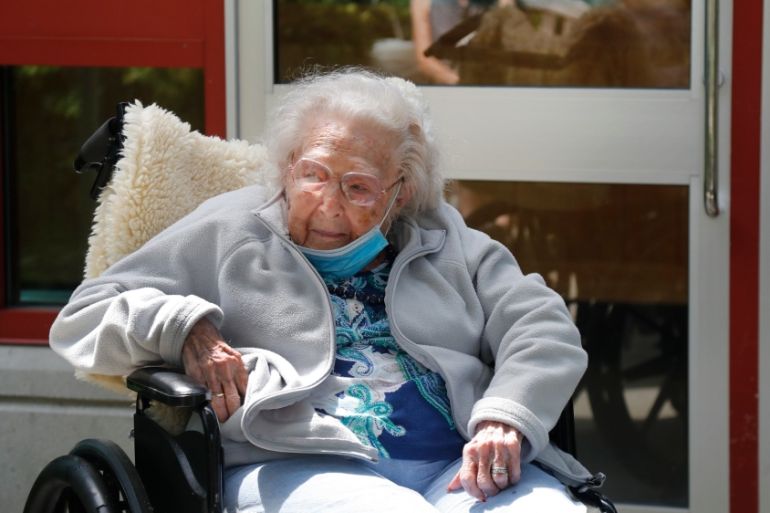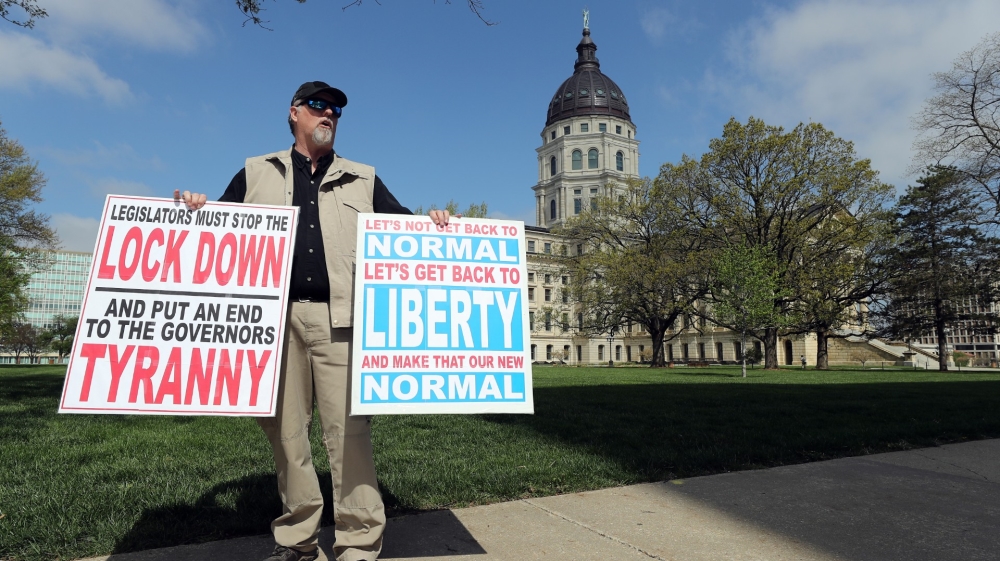COVID-19: Data reporting challenges in US states, nursing homes
Nursing homes are currently required to report data only from May, months after the coronavirus pandemic started.

Data on the US coronavirus crisis has been easy to find for those seeking a nationwide total, but state-by-state numbers on specifics like nursing home infections are more difficult to locate because of uneven reporting standards.
When the Trump administration required nursing homes to report their COVID-19 cases, it also promised to make the data available to residents, families and the public in a user-friendly way.
Keep reading
list of 4 itemsMexico’s teachers seek relief from pandemic-era spike in school robberies
‘A bad chapter’: Tracing the origins of Ecuador’s rise in gang violence
Why is the US economy so resilient?
But some facilities that have had coronavirus cases and deaths turn up as having none on Medicare’s COVID-19 nursing home website. The data may be incomplete because the reporting requirements do not reach back to the start of the pandemic. Numbers do not necessarily portray the full picture.
“The biggest thing that needs to be taken away” from the website maintained by the Centers for Medicare and Medicaid Services (CMS), “is in its current form, it is really leaving consumers in the dark,” Sam Brooks, project manager for Consumer Voice, told The Associated Press.
Consumer Voice is a national advocacy group for improved quality in long-term care.
|
|
Nursing homes are only required to provide CMS with data on coronavirus cases and deaths among residents and staff as of May 8, or more than two months after the first outbreak in a US facility was reported.
Nursing homes have the option of full disclosure, but not all have taken it, and there is no penalty for withholding older data that may reflect poorly on them. Many nursing homes are for-profit businesses.
The information missing from early in the pandemic leads to some puzzling results on the website.
For example, a nursing home that had one of the first major reported outbreaks in the country – Life Care Center of Kirkland, Washington – shows no confirmed COVID-19 cases and no deaths on the CMS data page.
A spokesman for Life Care Centers of America, a major chain, said the company is providing the information the government requested.
“We are reporting what CMS is asking us to report to them,” Tim Killian told the AP. “We are not evading them in any way.
“The Kirkland facility is now COVID-free, and it has been for some time,” Killian added.
The data showing no cases “is a snapshot of what is currently in the facility”.
The company said its cumulative count shows 100 residents tested positive, and 34 died. “You can ask us directly, and we’ll give you the exact numbers,” said Killian.
But consumer advocate Brooks said that information should be on the government website.
As it stands, the site “doesn’t tell the whole picture”, he said. “You are not going to be able to look at a home and make an informed decision.”
The estimated 1.4 million people living in some 15,500 nursing homes represent a tiny share of the US population, but they have borne a disproportionate share of coronavirus deaths. Nursing homes are only now starting to emerge from a national lockdown that took effect in mid-March.
According to the latest CMS figures, more than 33,000 nursing home residents have died in the pandemic.
A running tally by The Associated Press, which also includes other long-term care facilities and staff, as well as residents, shows more than 55,000 deaths.

Depending on the total count, that translates from about one-fourth of the deaths to more than 40 percent, strikingly high proportions in either case.
CMS, which sets standards for nursing homes, said protecting residents is a top priority, and “transparency and information sharing has proven to be one of the keys to the battle against this pandemic”.
But the agency said it lacked the legal authority to require nursing homes to disclose COVID-19 information from before the effective date of its reporting rule in May.
State reporting
Delegation of reporting powers to states has presented limitations, too, as states have different reporting standards.
Florida, a new hot spot for cases – the state’s confirmed caseload has doubled from 100,000 to 200,00 since June 22 – has faced criticism for its reporting.
More than 48 hospitals in Florida on Tuesday reported that their intensive care units had reached capacity as COVID-19 cases continue to surge in the state and throughout the country.
Hospital ICUs were full at 54 hospitals across 25 of Florida’s 67 counties, according to state data published on Tuesday morning. More than 300 hospitals were included in the report, but not all had adult ICUs.
Florida did not begin reporting current hospitalisations until the first week of July.
In Florida, the data scientist who developed the state’s coronavirus dashboard, Rebekah Jones, said in May that she was fired for refusing to manipulate data “to drum up support for the plan to reopen.”
Jones has since created her own dashboard, which includes data from those without valid Florida addresses, among other markers.

The Florida Department of Health told local media that the dashboard “sources much of its data directly from the Department’s Dashboard. The remainder is either self-reported or derived from unofficial sources”.
It continued: “The Department’s goal has always been to provide accurate, confirmed information regarding COVID-19 in Florida in as expeditious a manner as is possible. We will continue to employ only official sources of information, ensuring that our online resources are the most factual and up-to-date available.”
Governor of Massachusetts Charlie Baker also filed a new bill to expand data collection in June, a day after signing into law an expansion of data collection requirements.
Baker hoped the new regulations would “put a finer point” on the data.